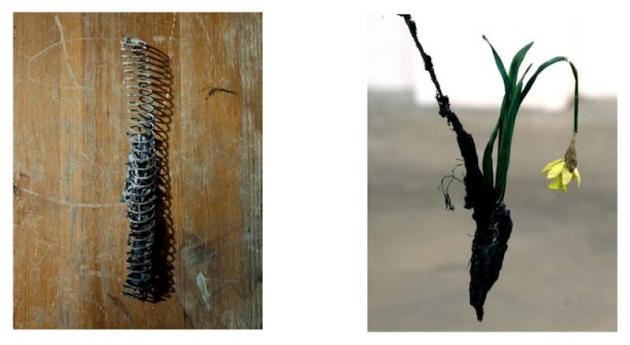Nature Reserves is “an exhibition conceived to explore how different methods of archiving might impact on the human-nature relationship”. So says curator Tom Jeffreys in his catalogue essay that pulls off the rare feat of being both lengthy (by my yard stick anyway) and highly engaging. Later in the essay he goes on to say that the exhibition is underpinned by “an interest in environmental ethics: what ought we to do?” The essay quotes Derrida, Darwin and David E Cooper (whoever he might be); but don’t let that put you off because it also exudes warmth, enthusiasm and sensitivity. And it quote The Smiths. The point I’m trying to make is that if you come away from this exhibition without having read Mr Jeffreys essay you may risk coming away with only half the story. The question is: how important is the story?
The exhibition is quiet and thoughtful, revealing itself in the detail, micro-detail even. It isn’t the sort of exhibition that will repay a flying visit, a casual scanning of the walls as one dashes from a to b via c. It is not an exhibition that relies on drama or grandiosity to make its point. Neither is it an exhibition lost in theory. In short there aren’t many exhibitions like this: motivated by genuine enquiry, with the observations made along the path of that enquiry whispered to the viewer who chooses to listen rather than shouted at those who choose not to.
The essay – and thereby the exhibition – comes alive through Mr Jeffreys personal musings on the tale of the exhibitions preparation and research processes; his stay in a cottage in Scotland (“the nightling sky glows indigo within white-painted window frames”); the delightfully unexpected highs and lows of his enthusiastic amateur botany (“a shore-line plant that, earlier in the day, was providing such a draw to a loose cluster of thrumming bumble bees as I sat nearby half-snoozing in a stripy deckchair”); and the key question that all of this throws up as he rummages through a forgotten copy of the Field Guide to the Wild Flowers of Britain: “Why do I even want to know?”
The answer to that question may have something to do with the elevation of intellectual knowledge above all other forms of understanding. We seem to believe that if we understand something intellectually then we have somehow mastered it, by which we mean, of course, gained mastery over it, imprisoned it in a cage of words, the very cage that blinds us to ever seeing it for what it really is. Interestingly this is exactly where artists come into their own, their role very often being to investigate the world through means other than the logicising and categorising left-brained intellect.
The exhibition includes the work of twelve artists (all women, interestingly, but that’s a story for another day), plus items lent by a selection of museums and institutions. Hours can be spent pouring over the minutia of what is to be found here on display. One almost feels like an archivist oneself, pressing ones nose to the glass in an attempt to understand, to somehow allocate meaning to something that is, essentially, beyond meaning.
Examples of the gems include trays of labels that have become detached from the specimens they were created for, as lent by the Grant Museum of Zoology, along with the revealing statement by Grant’s curator Mark Carnall that archives “in some sense are more important than the objects themselves”.
PINE, by artist, poet and academic Amy Cutler that presents a section of tree felled to reveal the marks of its temporal trauma; two lines of a poem in French projected onto it translate as: “Tell me have I come back / from that other world?” The intriguing and potent Collected Silences for Lord Rothschild by Sally Ann McIntyre, a sound piece heard through headphones that consists of five recordings of the silences of extinct bird specimens all wiped out in the late 19th and early 20th centuries as a direct result of the impact of European colonisation on New Zealand. And Hestia Peppe’s Microbial Familiars, an installation created specifically for Nature Reserves involving vessels of live Kombucha tea in which acetobacters, yeasts and other microbes apparently create themselves in direct response to their environment, in so doing generating a living archive of the exhibition space in their own DNA. I have no idea how that all works but it sounds fascinating.
And so it is with the exhibition itself. So rich and so deeply researched is this project that I couldn’t begin to understand it all intellectually without reading non stop for months and months on end – a handy and extensive reading list is supplied by Mr Jeffreys for exactly that purpose. I must confess I haven’t so far got underway with the reading list and yet, funnily enough, I’m delighted to report that my ignorance doesn’t seem to have had too detrimental an effect on my enjoyment of the exhibition. Maybe then knowledge isn’t quite as important as it would have us believe.
Words: Beverley Knowles Photo: L to R Theresa Moerman Ib, Backbone, 2013 Laura O’Neill, Toughen Up (Weeds), 2013
Nature Reserves: Curated by Tom Jeffreys 26 July until 13 September 2013 GV Art gallery, London, 49 Chiltern Street, Marylebone, London W1U 6LY

